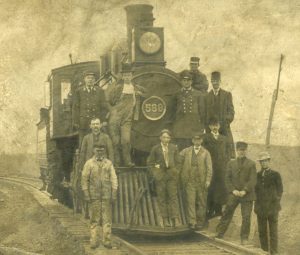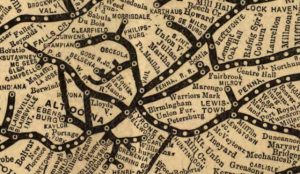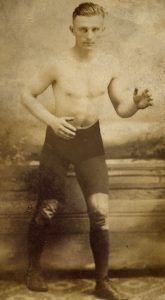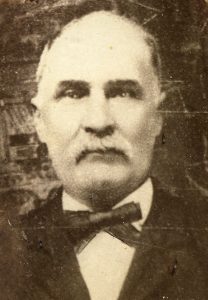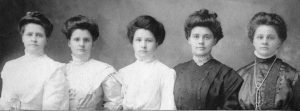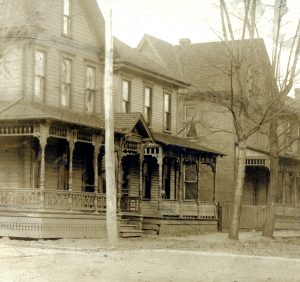Samuel Basom was born about 1792, possibly in Dauphin County. When he was young his parents bought a farm in Greenwood Township, Cumberland County (later Perry County). Samuel probably grew up on the farm there with his many brothers and sisters. His parents Rudy and Elizabeth died within a few years of each other in 1813 and 1816, leaving behind a large family of grown sons and younger children. The grown sons, including Samuel, may have taken some of the younger ones into their families.
There are only a few records for Samuel, and many blanks in his history. Even the list of his children is conjectural. In 1830 he was in Fermanagh, Mifflin County with a wife and five children, two boys and three girls.1 His wife was Barbara Page, daughter of George and Rebecca. The will of her father George Page, proved in 1815 and supposedly written in 1811, includes a daughter, Barbara, who married a Basom.2 To be married by 1811, she was probably born about 1792, about the same age as Samuel. Samuel and Barbara came from Mennonite families, and the Mennonites had no tradition of keeping vital records.3
In 1840 Samuel was no longer in Fermanagh Township.4 There was a Samuel Basan or Basam in two nearby townships, one in Decatur with ten children, and one in Granville with six children.5.] It is difficult to decide which of these might be the right Samuel. It does seem more likely that he did not have ten children. Samuel supposedly died in 1847 in Mifflintown, which is close to both Decatur and Granville, across the line in Juniata County. Barbara outlived Samuel by twenty-five years.6
Because Samuel died relatively young, he did not live to see the Civil War, and the problem it posed for Mennonites, who had a strong pacifist tradition. The state of Pennsylvania permitted them to file conscientious objector depositions, yet many chose to enlist, including Samuel’s son Simon. Would he have enlisted if Samuel were still alive?7
Samuel and Barbara had five children shown in the 1830 census record. The names of some of them are known, although it should be kept in mind that some of these might be children of his brother Jacob, and conversely some children listed for Jacob may actually be children of Samuel. There are clues that help place children in this family. Amos and Simon were both carpenters and both lived in Fermanagh Township, Mifflin County, as did their presumed sisters Martha Ellis and Elizabeth Reynolds. Catherine and Christian Martin lived in Greenwood Township, and her placement in this family is probably the weakest of the five. There was a Philip Basom taxed in Tuscarora Township, Juniata County, in 1851 as a laborer; he could have been another son. After that he disappears from local records.
After Samuel died Barbara lived with her old neighbors Joseph and Polly Pannebaker in 1850, possibly keeping house for them.8 (They were adjoining Samuel and Barbara in the 1830 census.) Barbara was listed in the census as 50 years old, making her born in 1800, surely off by several years. Joseph and Polly’s son Moses Pannebaker would grow up to marry Martha Basom, Barbara’s granddaughter.
According to a Juniata County newspaper, Barbara Basom died in Mifflintown, Juniata County on May 26, 1873 at the age of 77 years and 17 days. 9 This very specific date also has to be off by several years.
It is interesting that Samuel and Barbara named a son Amos Winey Basom.There was a large Winey family in the area, Mennonites, with an Amos born 1800, son of Jacob Winey and Anna Keeler. Amos was an admirable Mennonite, raising 13 children, four of whom became ministers.10 Since there is no obvious family relation between Samuel and Barbara and the Wineys, the name was possibly a tribute to Amos as a fellow Mennonite.
Probable children of Samuel and Barbara:11
The evidence for Catherine is weakest of these five. She may be a daughter of Jacob and Catherine instead. The evidence for Martha, Amos, Simon and Elizabeth is stronger, and is strongly based on where they lived.
Catherine, b. ab. 1820, m. Christian Martin, lived in Juniata County where he was a carpenter.12 In 1850 they were in Greenwood Township, in 1860 in Monroe Township (split off from Greenwood in 1858). Catherine was his second wife, married on June 12, 1842; they had thirteen children in addition to the six with his first wife.13 By 1870 they were in Fayette County, Iowa, where Christian worked as a millwright. Catherine died between 1870 and 1880. In 1880 Christian had only one child at home, the youngest, age twelve. Christian died in 1884, in West Union, Fayette County.
Children of Catherine and Christian:14
Mary, b. ab. 1844, no further information
James, b. ab. 1845, an apprentice carpenter in 1860, no further information
Henry Clay, b. 1846, d. 1921 in Buchanan County, MO; m. Freda Julia Schieber, fought in the Civil War, a farmer.
William, b. ab. 1848, no further information
Jacob, b. ab. 1850, no further information
Clara Ann, b. ab. 1858, m. Henry Bartlett in 1906 in Brainard, Fayette County, Iowa , as Caroline Reed.
Franklin Pierce, b. 1852, d. 1932 in Fayette County, Iowa, m. Sarah Hopkins; a farmer
John, b. ab. 1854, m. Louisa Rogers, living in Fayette County in 1925
Charlie, b. ab. 1857, m. Hattie Bates, living in Fayette County in 1925
Margaret, “Maggie”, b. 1861, m. 1) Bill Basford in 1882; he died in 1885; m. 2) John H. Bartlett in 1893; moved to DeKalb county, Missouri by 1900, widowed by 1910, died 1914 in Fayette County, Iowa.
Sarah, b. 1864, m. George Tripp, a farmer in Pleasant Grove, Fayette County, Iowa; she d. 1934, buried there.
George, b. ab. 1867, no further information
Martha “Muzzy” was born Aug 1822 in Juniata Co. She married Alexander Ellis about 1839; she was quite young. They settled in Fermanagh Township, Juniata County, where he was a blacksmith. They had four children by 1850, and added more by 1860. In 1870 they were in Mifflintown, still with six children, and moved to Lewistown by 1880.15 Alexander died in Aug 1886, and Martha went to live with her son Steward, a grocery man in Mifflintown; there in 1900.16 She died 7 Dec 1904 in Mifflintown, was buried at Westminster Presbyterian Cemetery.
Children of Alexander and Martha:17
Catherine Sarah, b. 1844, d. 1917, m. John Stump, lived in Mifflintown.
Mary, b. 1847, d. 1931 in Madison County, Nebraska, m. Augustus Cunningham; he was a farmer.
William, b. 1849, d. 1932 in Harrisburg, m. Annie Kinser, m. 1911 Effie Mills; he was a blacksmith.
Everard, b. 1852, d. 1923 in South Bend, Indiana, m. Mary Ann Chubb. A blacksmith, he probably moved to South Bend to work at the large Oliver Plow Works there. Died in 1923 when he was run over by a truck.
Caroline (Carrie), b. 1853, single in 1880 census.
Stewart, b. 1858, d. 1935 in Mifflintown, m. Mary Martha “Mattie” Hinkle, kept a general store in Mifflintown for many years.
Ida Rebecca “Becky”, b. 1861, d. 1924 in Lewistown, m. 1882 Samuel Rarrick; he was a brakeman for the railroad.
John Bradford, b. 1863, m. Ida LNU; he was a machinist in Lewistown in 1900.
Amos Winey was born in April 1824. He married Sarah McCurdy in 1848 and in 1850 they were living on the farm of her father Thomas in Fermanagh Township, Juniata County.18 Although he worked as a farmer, he also appears on the tax list for Fermanagh as a cabinetmaker.19 In 1855 Amos and Sarah moved to Iowa, and had three children there: Fremont, Victoria J. and Eva.20 In 1856 he was assessed for keeping a hotel.21
Amos had a bad temper and did not get along with his family; in fact he left them for several years and went back to Pennsylvania. His daughter Eva and her husband moved in with Sarah and helped her run the farm. At the time Amos promised the farm to Fremont if he would take care of Sarah. As Fremont testified later in court, “Father said to me: “I am going to leave. I am going away and if you will stay and take care of mother we will give you this eighty acres of land at her death. And I told him I would. Father done the principal part of the talking.” Amos went away for several years, then returned to Iowa.
Sarah died in 1893. After her death Amos and his daughters took Fremont to court over the farm. The court ruled that whatever agreement was made was superceded by later arrangements between Sarah and Fremont.22 Amos died in March 1900 and was buried in Carrollton.23 He and Sarah are buried together in Dedham Cemetery.24
Taylor Fremont, b. 1851, d. 1911, buried Dedham Cemetery, Carroll County, Iowa, m. 1874 Lucinda Cretzinger, had six children.
Victoria Jane, b. 1851, d. 1906, buried Dedham Cemetery, Carroll County, Iowa, m. William Spencer Winnette
Eva, b. Aug 1858, m. 1) Evan Heater, m. 2) FNU McDonald, m. 3) in 1899 Joseph Blake26, possibly m. 4) Evan Heater again, m. 5) T. A. Davis. She lived in Ainsworth, Nebraska (with Heater), Carroll County, Iowa (with McDonald and Blake), Van Buren County, Arkansas (with Heater the second time around and with Davis). She had children Charles W, Pearl W, Earl, Winnie.
Simon was born about 1825 and moved to Mifflintown as a young man, working as a chair maker. He married Lydia Howe about 1846 and had two daughters with her before her death. Then he married Susanna Boyd in 1854 and had two daughters and a son with her. In 1862 Simon enlisted in the Civil War. His regiment, the 126th, marched toward Antietam, arrived too late for that battle, but fought at the battle of Fredericksburg. Simon was coughing up blood, probably from tuberculosis, and was unable to fight. He was discharged a month later, in January 1863 and returned home.27 After his discharge he returned home to Mifflintown and worked as a painter. He died in 1874, at a relatively young age, and was buried in Union Cemetery, Walker Township. Susan moved to Sandusky, Ohio, with her two daughters Maggie and Mary, and died in 1884 at the house of her daughter Maggie Fought in Fremont, Ohio.
Children of Simon and Lydia:
Hannah Jane, “Jane or Jennie”, b. 18 May 1847, m. Samuel H. Showers, a coachmaker, as his second wife; he had three children with his first wife Euphemia North and four children with Hannah Jane. After Samuel died in 1904 she may have married again. Jane died in 1911.28
Martha Hamlin, b. 1849, d. 1910, m. 1866 Moses Pannebaker, son of Joseph & Polly.29 Moses worked as a blacksmith as a young man, served in the Civil War, came back, married Martha, worked as a house painter for her father Simon Basom. Moses and Martha had nine children before her death in 1910 from consumption.30 He married Mary Ella Swilger in 1912 and died in 1921. Moses and Martha are buried together at Westminster Presbyterian Cemetery in Mifflintown.31
Children of Simon and Susan:
Margaret, b. Sept 1857, d. 1930, married William E. Fought on Aug 25, 1881 in Sandusky, Ohio32. She was his second wife, he had a son with his first wife Sarah Richards. He was born in 1852 in Sandusky County, worked as a farmer and carpenter, he died suddenly in 1920, left Margaret and 4 sons: Arthur (with his first wife), Clarence, Harry and Earl. William and Margaret lived in Fremont, Ohio.33 They are buried together at Four Mill House Cemetery, Fremont.
Mary, b. ab. 1857, married John Wesley Shirk (b. 1853), lived in Tyrone; he was a house carpenter.34
John W, b. ab. 1858, no record past the 1860 census, probably died young
Elizabeth, born April 29, 1828, died June 21, 1906 in Fermanagh Township, Juniata County, married Jacob Reynolds, buried at Lost Creek Cemetery.35 In 1860 census they were in Fermanagh, with seven children.36 Jacob registered for the draft for the Civil War in 1863, for the 9-months service, living in Fermanagh.37 In the 1870 census he was back in Fermanagh; a farmer.38 He died in 1872; Elizabeth stayed on the farm after his death. Two of her sons, Samuel and David, were boarding in the McAlisterville Soldiers Orphan School in 1880. Elizabeth died in 1906 and is buried with Jacob at Little Creek Mennonite Cemetery.
Children of Elizabeth and Jacob:39
Frances, b. 1848, d. 1923, m. David E. Shellenberger, lived in Altoona
Lewis, b. 1849, d. 1898, m. Annie King
Jane, b. 1850, no further information
Henry, b. 1853, in 1870 working on the farm of D. Shellenberger, no further information
Debra Emma, b. ab. 1856, no further information
William Henry, b. 1858, d. 1924 in Jackson County, Michigan, a farmer, married Fiedella Street.
John H, b. 1860, no records past 1870
Ada C., b. ab. 1862, no records past 1870
Anna Mary, b. 1864, d. 1920 in Jackson County, Michigan, m. 1) Harrington, m. 2) 1907 William Straight; William was a carpenter.
Samuel B, b. ab. 1865, , d. 1890, buried at Lost Creek Mennonite Cemetery, m. Emma Woods
David Simon, b. 1867, d. 1952, a farmer, m. Bertha Pannebaker
Elizabeth, b. 1869, d. 1955 in Otsego County, Michigan, m. John W. Bruder in 1895
Rebecca May, b. 1871, d. 1943, m. James Cummings in 1900 in Juniata County, he was a blacksmith.
- 1830 federal census, Fermanagh Township, Mifflin County, indexed as Bsam or Basam. The girl between 15 and 19 may have been a servant, since the oldest known surviving daughter (Catherine) was not born until about 1820. ↩
- George Barge was born in 1763 in Dauphin County, married a woman named Rebecca, moved to Greenwood Township and later to Mahantango Township, and had a number of children, including a son who married into the Auker family and a daughter Barbara, named in his will of 1811 as married to a Basem. The will was quoted in Pennsylvania Roots and Spreading Branches. ↩
- Some historians have said that this is a reflection of their persecution in Europe, where records could be used against them. ↩
- I browsed all the images for the township, included under Mifflintown on Ancestry. ↩
- The Decatur record was in Decatur Township, Mifflin County, image 7, not indexed, looks like Bsam. The Granville record was in Granville Township, Mifflin County, image 5, indexed as Sameul Bran [sic ↩
- I have not found her in a census record for 1860 or 1870. ↩
- GAMEO (Global Anabaptist Mennonite Encyclopedia Online), entry for American Civil War (1861-1865). ↩
- 1850 federal census, Mifflintown, Juniata County, Image 18. There was no occupation listed for Barbara, such as housekeeper or servant, leaving her status indeterminate. ↩
- Juniata County Newspapers 1800 Abstracts of Births & Deaths… Juniata County Historical Society. ↩
- Obituary of his daughter Mary E. Graybill, died 1934, online. ↩
- Conjectured, since there are no birth records known. K. Varden Leasa placed Martha in the family of Jacob and Catherine, since they had a “missing” daughter in the 1830 census. He found Alexander Ellis in the 1840 census in Mifflintown with a female under 20 years old, probably Martha. (post to PAJuniat mailing list on 04 Nov 2006). The note for Martha Basom Ellis on pennsylvaniagravestones.org places her as a daughter of Jacob and Catherine. ↩
- 1850 federal census; 1860 federal census; letter to the Juniata County Historical Society, 2005, Basom file, from a descendent. ↩
- 1850 census Greenwood Twp, Juniata County, Image 2; 1860 census, Monroe Twp, Juniata County, Image 10. Marriage record, unknown church in Perry County, both of Juniata County. One web tree gives his first wife as Hannah Graybill, daughter of Jacob and Magdalena Mary Schneider, no evidence given. ↩
- 1850 and 1860 census, Monroe Township, Juniata County; 1870 census West Union Township, Fayette County, Iowa, Image 26. Spouses from the Iowa State Census Collection 1836-1925 on Ancestry. Other information from death certificates, records saved on Ancestry trees, Findagrave. All of these children were born in Pennsylvania. ↩
- 1850 federal census, Mifflintown, Juniata County, Image 24; 1860 federal census, Fermanagh, Juniata County, Image 23; 1870 federal census, Mifflintown, Juniata County, Image 18-19; 1880 federal census, Lewistown, Juniata County, Image 19 ↩
- 1900 federal census, Mifflintown, Juniata County, Image 7-8. ↩
- The dates and names of spouses are from Ancestry trees; further information from census records. ↩
- 1850 census, written and indexed as Besome. ↩
- Juniata County tax records, 1848, 1850, 1851, Juniata County Historical Society. ↩
- Query letter to the Juniata County Historical Society. He was in Iowa for the census of 1860 through 1880. In 1850 he and Sarah were living with her father Thomas in Fermanagh Township, Juniata County (indexed as Besome). ↩
- IRS tax assessment 1856, Carrollton, Carroll County, on Ancestry. ↩
- The court case is online at: https://archive.org/stream/reportscasesatl22barlgoog/reportscasesatl22barlgoog_djvu.txt. ↩
- His obituary in the Carroll Sentinel obituary (saved on an Ancestry tree) called him A. Winey Basom, b. April 14, 1824, in Union County PA near Coller’s Mills. He became a Methodist, married Sarah L. McCurdy on Sept 7, 1848, moved to Carrollton in 1855, died March 5, 1900. ↩
- Findagrave ↩
- Census records, Ancestry trees, Findagrave, Iowa State Marriage records, Iowa Supreme Court cases, family Bible of Thomas McCurdy. ↩
- Iowa Marriage Records 1800-1937, 1899, Image171. Her third marriage. The record gave her name as Eva McDonald. ↩
- Susan’s application for a Civil War pension. ↩
- Findagrave; 1910 federal census, Jefferson Twp, Butler County, PA, Image 25, Joseph and Jennie Postlethwait, married for three years. Not certain that this is Jennie. ↩
- The Hamlin family is prominent in Juniata County, but there seems to be no relation. The best explanation for Martha’s middle name is that she was probably delivered by Dr. Philo Hamlin. He was a nephew of Ezra Doty, who took over his uncle’s practice in 1828 and worked until 1866, “beloved by the community.” Ref: Ellis and Hungerford. ↩
- Death certificate of Martha Hamlin Pannabaker: Died in Juniata, Mifflintown, on 1/9/1910. She was a housewife. Born 1/25/1849. Mother Liddie Howe. Father Simon Basom. Information from funeral director, Mifflintown. Buried in the Presbyterian cemetery. ↩
- He is buried together with Martha, Boyd, Joseph, Clarence, Daisy wife of Clarence, and their son Clarence. ↩
- Ohio County Marriages 1774-1993, Sandusky, on Ancestry. ↩
- His obituary, Fremont Daily News, March 16, 1920, saved on an Ancestry tree. ↩
- 1910 federal census, Blair County, Tyrone Ward 1, district 0085, Image 12. ↩
- The PA death certificate for her shows the dates of birth and death and the names of her parents, as Samuel Basom and Barbara Page. This is one of the key pieces of evidence for the identity of Samuel’s wife. The informant for the death certificate was David Reynolds of Mifflintown. ↩
- 1860 federal census, Fermanagh Township, Juniata County, Image 21. ↩
- US Draft Registration Records, 1863-1865, PA 14th, Image 479. ↩
- 1870 federal census, Fermanagh Township, Mifflin County, Image 11. The nine children were at home; the oldest worked for the railroad. ↩
- Ancestry trees, census records, Findagrave, marriage records. ↩

